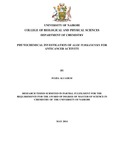| dc.description.abstract | Cancer cases are on the increase all over the world including Sub-Saharan countries. In the search for new anticancer drugs, nature remains an excellent source of lead compounds. Among various classes of natural compounds quinones are well known for their anticancer activities some being drugs (e.g. daunomycin and doxorubicin). The genus Aloe including Aloe turkanensis is a rich source of quinones.
The dried and ground rhizomes and leaves of Aloe turkanensis were exhaustively extracted with dichloromethane/methanol (1:1) by cold percolation. The crude extracts exerted cytotoxic activity against human extra hepatic bile duct cancer cell line (TFK-1) by showing significant reduction in cell viability. The crude extracts were then subjected to chromatographic separations on silica gel, Sephadex LH-20 and preparative TLC, which resulted in the isolation of twelve compounds. The structures of the isolated compounds were determined using spectroscopic methods including UV, 1H and 13C NMR, COSY, NOESY, HMBC and HSQC. These compounds were two naphthoquinones [3,5,8-trihydroxy-2-methylnaphthalene-1,4-dione (1) and 5,8-dihydroxy-3-methoxy-2-methylnaphthalene-1,4-dione (2)], seven anthraquinones [chrysophanol (3), aloesaponarin I (4), aloesaponarin II (5), laccaic acid D methyl ester (6) helminthosporin (8) aloe-emodin (10) and α-L-11-O-rhamnopyranosylaloe-emodin (11)], a preanthraquinone [aloesaponol I (7)] a pyrone derivative [feralolide (9)] and a benzoic acid derivative [3,4-dihydroxybenzoic acid (12)]. The naphthoquinones [3,5,8-trihydroxy-2-methylnaphthalene-1,4-dione (1) and 5,8-dihydroxy-2-methoxy-2-methylnaphthalene-1,4-dione (2)] is here reported for the second time from the genus Aloe. Furthermore, 3,5,8-trihydroxy-2-methylnaphthalene-1,4-dione (1) is reported here for the first time from the family Asphodelaceae.
The in-vitro anticancer activities of the isolated compounds were conducted against the human extra hepatic bile duct carcinoma (TFK-1) and liver (HuH7) cancer cell lines. Based on the 3-[4,5-dimethylthiazol-2-yl]-2-,5-diphenyltetrazolium bromide (MTT) assay, the anthraquinone aloe-emodin (10) and the naphthoquinone 5,8-dihydroxy-3-methoxy-2-methylnaphthalene-1,4-dione (2) exhibited high inhibition against TFK-1 cell lines with IC50 values of 6.0 and 15.0 μg/mL (in TFK-1 cells) and 31 and 20 μg/mL (in HuH7 cell line), respectively. The pre-anthraquinone aloesaponol I (7) inhibited the growth of TFK-1 cells with IC50 values of 10.0 μg/mL, and with 88.0 μg/mL against the HuH7 cells. The aloe-emodin glycoside, α-L-11-O-rhamnopyranosylaloe-emodin (11) and the anthraquinone aloesaponarin II (4) inhibited viability of TKF-1 cell line with IC50 values of 23.0 μg/mL and 34.0 μg/mL, respectively; and with IC50 values of 47.0 μg/mL and 55.0 μg/mL in HuH7 cell lines, respectively. Helminthosporin (8) also significantly inhibited the growth of TFK-1 cells with IC50 values of 46.0 μg/mL but did not inhibit the HuH7 cells at the tested concentrations. This is the first report on the anticancer activity of the isolated compounds against extra hepatic bile duct (TFK-1) and liver (HuH7) cancer cell lines. Further investigation on normal cell lines and their mechanism of action has to be estsblished before the potential of these compounds as anticancer drugs can be established. | en_US |

